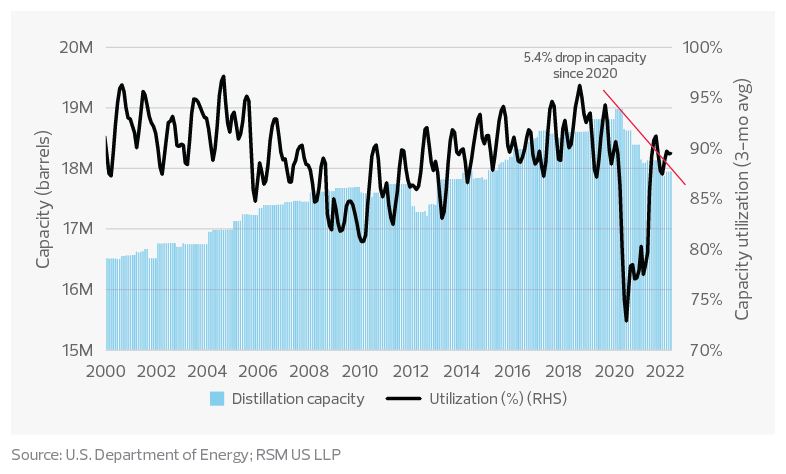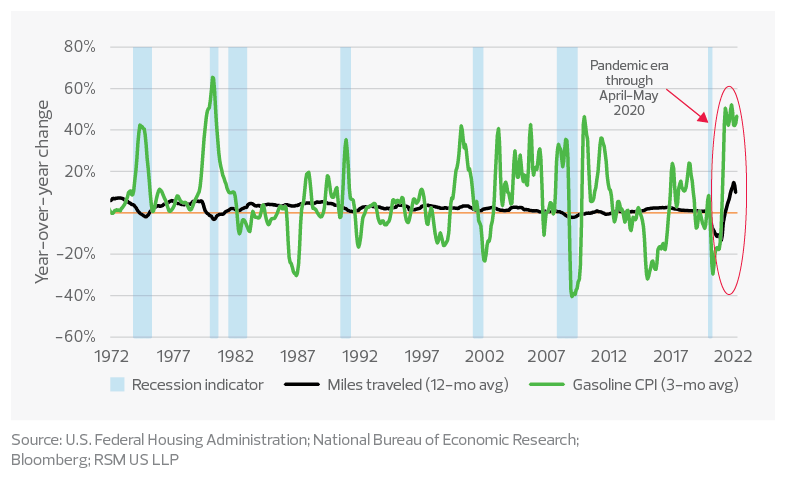11 Jul 2022 Fuel Oil Prices Reaching a Tipping Point
Authored by RSM US LLP, July 11, 2022
American households are consuming less gasoline compared to this time last year as fuel costs continue their relentless rise.
Now, with the traditional summer driving season underway, these costs have reached a tipping point, forcing many households to reduce their spending on necessities and threatening to slow the overall pace of consumption.
Any further increase in oil and gasoline costs from current elevated levels will result in a major pivot that will send the economy uncomfortably close toward recession in the near term.
And there is little relief in sight as another round of increases in oil and energy prices linked to geopolitical tensions looms.
U.S. consumption of gasoline*

This downtrend in consumption began when the price of crude oil firmly entered the public consciousness this year. Crude moved above $100 per barrel in early March and then embarked on a series of higher highs and higher lows. By the middle of June, the cost of driving had increased by 50% in less than six months, with price increases approaching growth rates of the 1970s-80s oil crises.
There are several reasons for the sustained increase. First and foremost, consumer demand surged beginning last summer when vaccines made it safer for Americans to venture out.
But it took a while for crude production to restart following a decadelong period where investors took a more cautious approach to finance new production. Then came the Russian invasion of Ukraine, and oil prices exploded higher.
Growth rates of gasoline prices and vehicle miles traveled

It is also important to note that it wasn’t just extraction that was in decline. Refineries reached a peak in their capacity in early 2020 before dropping by 5.4% this past March.
U.S. crude oil refinery capacity and utilization rate

According to the U.S. Energy Information Administration, refinery costs in April comprised 17% of the retail price of gasoline, with the price of crude accounting for 60% of prices at the pump.
With rising extraction and refining costs, there was little outcome other than further increases in prices at the pump.
Diesel prices
Although consumers will be more aware of the increased cost of filling their tanks with gasoline this summer, the most significant damage to the economy and household balance sheets might well come from the increase in diesel prices. That is, consumers can choose not to take a long drive, but they cannot avoid spending more on food and school supplies because of the indirect cost of diesel.
What we pay for in a gallon of:

That’s because diesel is used to plant and harvest crops and move the food to market. And diesel transports products from Shanghai to Los Angeles to warehouses and shops. So, as long as our reliance on fossil fuels continues, consumers can expect to be stuck with the indirect costs of diesel.
Retail gasoline prices increased by 62% over three years, from $2.79 per gallon in June 2019 to $4.52 in mid-June.
Over that same timespan, the retail diesel price increased by 75%, from $3.13 to $5.47. Much of the diesel price increase is because of the 113% jump in refining costs, from $0.75 to $1.59 a gallon.
The takeaway
Fossil fuels will be part of the energy mix into the foreseeable future despite efforts to decarbonize the domestic and global economies. If there is a lesson to be learned from the unwillingness of investors to finance the reopening of wells, it is that there is a role for government, in partnership with the private sector, to finance the expansion of production and refining capacity.
In terms of inflation, demand for energy is relatively inelastic in the short term and we think that fuel prices have reached a tipping point with respect to reallocating consumer choice and dampening overall consumption.
While consumers can change buying habits in the long term—to alternatives like electric vehicles, for example—in the short term, they will have little choice but to spend more on necessities like gasoline, all of which raises the likelihood of a recession.
DO YOU HAVE QUESTIONS OR WANT TO TALK?
Fill out the form below and we’ll contact you to discuss your specific situation.
This article was written by Joe Brusuelas and originally appeared on 2022-07-11.
2022 RSM US LLP. All rights reserved.
https://rsmus.com/insights/economics/fuel-oil-prices-reaching-a-tipping-point.html
RSM US Alliance provides its members with access to resources of RSM US LLP. RSM US Alliance member firms are separate and independent businesses and legal entities that are responsible for their own acts and omissions, and each are separate and independent from RSM US LLP. RSM US LLP is the U.S. member firm of RSM International, a global network of independent audit, tax, and consulting firms. Members of RSM US Alliance have access to RSM International resources through RSM US LLP but are not member firms of RSM International. Visit rsmus.com/aboutus for more information regarding RSM US LLP and RSM International. The RSM(tm) brandmark is used under license by RSM US LLP. RSM US Alliance products and services are proprietary to RSM US LLP.

Haynie & Company is a proud member of RSM US Alliance, a premier affiliation of independent accounting and consulting firms in the United States. RSM US Alliance provides our firm with access to resources of RSM US LLP, the leading provider of audit, tax and consulting services focused on the middle market. RSM US LLP is a licensed CPA firm and the U.S. member of RSM International, a global network of independent audit, tax and consulting firms with more than 43,000 people in over 120 countries.
Our membership in RSM US Alliance has elevated our capabilities in the marketplace, helping to differentiate our firm from the competition while allowing us to maintain our independence and entrepreneurial culture. We have access to a valuable peer network of like-sized firms as well as a broad range of tools, expertise, and technical resources.

